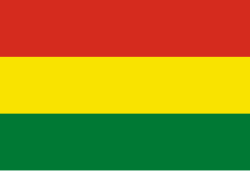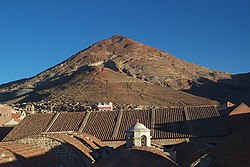Cerro Rico
| Cerro Rico | |
Cerro de Potosí Cerro Rico de Potosí Sumaq Urqu | |
| Berg | |
Cerro Rico, 2002 | |
| Land | |
|---|---|
| Departement | Potosí |
| Provins | Tomás Frías |
| Bergskedja | Anderna |
| Höjdläge | 4 800 m ö.h. cirka[1] |
| Koordinater | 19°37′06″S 65°45′00″V / 19.6183°S 65.7500°V |
| Geologi | Magmatiska bergarter |
| Period | Neogen[2][3] |
| Tidszon | BOT (UTC-4) |
| Geonames | 3907581 |
Cerro Ricos läge i Bolivia | |
Cerro Rico, även Cerro de Potosí, (quechua: Sumaq Urqu)[4] är ett berg i sydvästra Bolivia, känt för sina stora silverfyndigheter, som berikade det Spanska imperiet från 1500-talet och framåt.
Berget är en tidigare vulkan och ligger i Andernas östra kordiljära, öster om den andiska högplatån.[2] Toppen på Cerro Rico når cirka 4 800 meter över havet.[1]
Intill berget, på omkring 4 070 m ö.h.,[5] ligger staden Potosí, som är huvudort i departementet Potosí.
Historia
Cerro rico betyder "rikt berg"; och det sades i folkmun vara ”gjort av silver”.
Gruvorna lär genom åren ha gett mer än 60 000 ton silver och 100 000 ton tenn.[1][3]
Härifrån kom huvuddelen av det silver som berikade det Spanska imperiet från 1500-talet och framåt; hela 85 procent av allt silver från den tiden beräknas ha haft sitt ursprung i det här berget.[6]
Gruvbrytningen och anrikningen av silvret vid Cerro Rico beräknas ha tagit 8 miljoner människors liv under den spanska kolonialtiden,[7][4][8] varav många slavar från ursprungsbefolkningen och från Afrika.[2][9]
Nutid
Cerro Ricos gruvor sysselsätter fortfarande (2018) omkring 15 000 gruvarbetare.[8][10]
Arbetsförhållandena är dock svåra och gruvarbetarnas medellivslängd är inte mer än 40 år.[8][9]
År 2011 kollapsade en del av toppen och bildade en krater. Den riskerar störta in ytterligare, framför allt på grund av fortgånde gruvarbete på höga nivåer i berget.[11][12]
Källor
- ^ [a b c] Herbert Pöllmann (2017). Cerro Rico – a unique mineral and metal ore mountain BOMGEAM, Grupo de Mineralogia e Geoquímica Aplicada (GMGA). Läst 27 februari 2021.
- ^ [a b c] W.H.J. Strosnider et al. Acid mine drainage at Cerro Rico de Potosí I: Unabated high-strength discharges reflect a five century legacy of mining Environmental Earth Sciences, 2011, 64, 899–910. Läst 27 februari 2021.
- ^ [a b] Charles G. Cunningham et al. (2005) Geology and Nonfuel Mineral Deposits of Latin America and Canada, U.S. Geological Survey Open-File Report 2005-1294B. Läst 27 februari 2021.
- ^ [a b] Teresa A. Meade (2016). A History of Modern Latin America: 1800 to the Present, John Wiley & Sons. Läst 25 februari 2021.
- ^ ”Página oficial de la ciudad de Potosí”. Arkiverad från originalet den 29 juni 2012. https://web.archive.org/web/20120629222755/http://www.potosi.com.bo/potositurismo/spanol/infutil.htm. Läst 27 februari 2021.
- ^ Weatherford, Jack (2010) [1st pub 1988]. Indian givers: how Native Americans transformed the world (2nd ed.). New York: Three Rivers Press. p. 6. ISBN 9780307717153. OCLC 656265477
- ^ Eduardo Galeano. Open Veins of Latin America: Five Centuries of the Pillage of a Continent, översatt från spanska av Cedric Belfrage. Monthly Review Press, 1997. ISBN 0-85345-991-6.
- ^ [a b c] Catharina Moh (2 oktober 2014). Cerro Rico: Devil worship on the man-eating mountain BBC News, Bolivia. Läst 27 februari 2021.
- ^ [a b] Review of Cerro Rico – The Silver Mountain London Mining Network, 28 augusti 2016. Läst 27 februari 2021.
- ^ Sofia Bonilla (12 januari 2018). Child Labor and the Mountain that Eats Men, The Bernard and Audre Rapoport Center for Human Rights and Justice, University of Texas School of Law. Läst 27 februari 2021.
- ^ Sara Shahriari (8 maj 2014). Bolivia: Struggling to save the mountain that eats men Al Jazeera America. Läst 27 februari 2021.
- ^ Dan Collyns (24 juni 2014). 'Bolivia's Cerro Rico mines killed my husband. Now they want my son', The Guardian. Läst 27 februari 2021.
Media som används på denna webbplats
| Bolivias flagga* | |
|---|---|
| country | Template:I18n/Republic of Bolivia |
| används av | Bolivia |
| från | 1851 |
| till | Present |
| skapad av | Government of Bolivia |
| format | 15:22 |
| form | rektangulär |
| färger | röd, gul, grön
flag has 3 horizontal stripes |
| andra egenskaper | A horizontal tricolor of red, yellow and green. |
Shiny red button/marker widget. Used to mark the location of something such as a tourist attraction.
Dibujo realizado por Francisco Tito Yupanqui publicado en El mundo desde Potosí. Vida y reflexiones de Bartolomé Arzans de Orsúa y Vela (1676-1736)
Författare/Upphovsman: User:Urutseg, Licens: CC0
Vertically stretched (105%) version of file Bolivia physical map.svg in order to have the same proportions as Bolivia location map.svg
Cerro Ricco bij Potosi, Bolivia.
Författare/Upphovsman: Dan Lundberg, Licens: CC BY-SA 2.0
Miners bring a loaded cart out of one of the mine shafts.
Potosí (elev. 4,090m/13,420ft) [for comparison: Lhasa, Tibet, at 3,658m/12,001ft] was founded in 1545 as a mining town at the foot of Rich Hill (Cerro Rico), the world’s largest silver deposit. An estimated 60% of all silver mined in the world during the second half of the 16th century came from Potosí which was reputed to be the world’s largest industrial complex at the time. Its population eventually exceeded 200,000 people, making it one of the largest cities in the world. Most of the mining and smelting (using mercury) was done by forced labor, both indigenous people and African slaves. As many as 8 million workers are estimated to have died between 1545 and 1825. Output began to decline in the early 19th century. By the 1890s, low silver prices prompted a shift to mining tin. Growing demand for tin this century by the electronics industry has helped the local economy. Silver extraction continues on a small scale.
Miguel de Cervantes’ novel “Don Quixote” describes Potosí as a land of “extraordinary richness” (chapter 71 in the second volume which was published in 1615).
The City of Potosí was declared a UNESCO World Heritage Site in 1987.
On Google Earth:
Cerro Rico 19°37'8.81"S, 65°45'1.12"W








